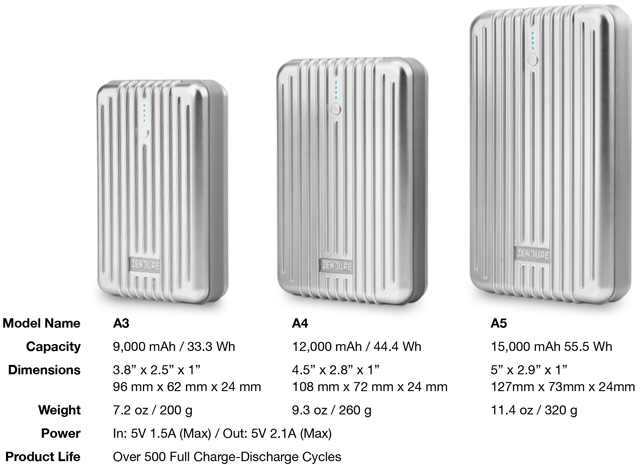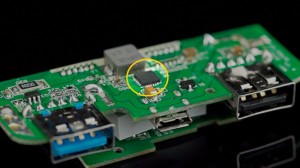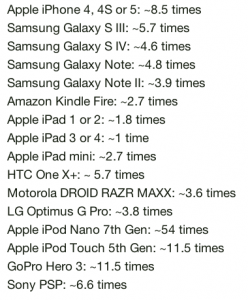There are already a large number of portable backup batteries for electronic devices on the market today. A quick Amazon search for “portable backup battery” returns a plethora of results for under the $39 asking price of the smallest Zendure such as the Anker Astro E3 which claims a 10,000mAh capacity. So what exactly sets the Zendure line apart? There’s a ton of marketing hooplah in their video about the excellent visual appeal of the product, but when you boil it down, they’re claiming two things: higher efficiency/capacity than competitors and more durability than competitors.
The Tech
The higher energy efficiency claims are really leaning heavily on the Texas Instruments brand:
“The essential charging and discharging operations of the Zendure A-Series battery are expertly coordinated by a Texas Instruments control chip. Decades of research into secondary batteries has been distilled into this tiny marvel. The result is an amazing boost to efficiency that fits into a space the size of a pill.”
They keep using this image:
which circles what looks like a 4x4mm VQFN or “Very thin Quad Flat Non-leaded” package. It’s hard to say exactly which part they’re using, but TI has a lot of parts in this space. The take home here is that Texas Instruments doesn’t design custom components for orders in the 700s. These guys are playing up that branding when in all likelihood, they just grabbed an off the shelf part (that costs a little over a dollar) and implemented it in the manner suggested by its data sheet.
What’s also kind of silly about this is that for a switch mode DC/DC converter (used here to step up the 3.7V of the battery to the 5V needed for charging a phone), the efficiency normally has more to do with the power components than the controller itself. Modern cellphones and tablets can take upwards of 2 amperes of current during charging, and the little device circled is certainly not capable of dealing with those kinds of currents. It’s simply controlling the components that are. I’d be more interested to see the DC resistance of the inductor behind the component circled.
Moving down the page, there is some more misleading information. They have a list of devices and the estimated number of times they can be fully charged from the Zendure A5’s 15,000mAh battery. They even provide a formula to let you approximate the number of charge cycles you can get for devices not listed:
“To approximate how many times a Zendure battery can charge your device, multiply the battery’s capacity by 0.8, and then divide it by the capacity of your device.”
The formula is good enough to take into account the claimed 80% efficiency of the Zendure, but it totally disregards the internal efficiency of the device being charged. If you haven’t noticed, when you plug your iPhone into a charger, it warms up a bit. This heat discharge is due to the inefficiencies of stepping down a 5V USB input to a 4.2V charging voltage as well as impedance inside the phone’s batteries themselves. It will take more energy to charge a phone than the phone actually stores due to this energy lost. The point is, the Zendure folks have no control over this, so that formula is a little too optimistic.
That’s okay, at least they have a list of devices with data that they probably captured from real world tests with their actual prototype:
Or did they? Looking up a few battery specs from iFixit tear downs, I came up with a short list of battery capacities and ran their formula:
| iPhone 4s | 1432mAh | 8.38 times |
| Samsung Galaxy SIII | 2100mAh | 5.714 times |
| Samsung Galaxy SIV | 2600mAh | 4.62 times |
| Samsung Galaxy Note | 2500mAh | 4.8 times |
Huh… So it looks like that data is derived directly from the specs of the devices and not at all from real world testing. I would be very interested to see if the actual device can charge a phone as many times as they claim.
Moving past the electrical, the durability claims seem pretty solid. The device is constructed from ABS plastic which is the same stuff they use to make TI-83+ calculators, and we all know how well they stand up to abuse. That’s why I’m not super surprised that their device survived getting run over with a car. I am a little curious about their choice of editing though:
I’m not claiming that they faked the test, but they certainly could have produced a more convincing video if they didn’t.
Marketing
That’s not the only bit of potential skeeviness with this campaign. The part of their description that first drew me into this product was some of the quotes by other bloggers writing about the campaign. I’m not too clear on the purpose of quoting other people talking about your product. Ordinarily, such quotes (normally coming from reviewers) would instill confidence in the reader that the claims aren’t totally fabricated as they have been corroborated by other parties. Of course, with a Kickstarter, everything tech journalists could potentially write about the product is based on information that they garnered from the Kickstarter description because the product doesn’t exist yet.
One particularly nefarious example of this is with a quote from Erin Carstens at DudeIWantThat.com:
Now let’s click the link and take a look at the context (emphasis mine):
“I don’t think the batteries come with a money-back guarantee for buyers who try to replicate the experiment without similar success, but it’s probably safe to say that the Zendure A-Series maintains its integrity and dependability when tossed in backpacks and luggage, or inadvertently dropped and impacted during futile efforts to charge while intoxicated.”
A lot of the things I’ve talked about in this post are in a bit of a gray area. Some of the claims are maybe a little too optimistic or just not specific enough, but whoever selected this quote to include in the Kickstarter description did so with the intention of misleading their backers.
Can they do it?
My prediction is that yes, they can deliver a product similar to the one they’re advertising. I don’t know where they’re getting their batteries, but the capacities they’re claiming are not that implausible. While their video is full of a lot of marketing garbage, they do have a few clips of real machines running real tests which speaks to this not being a total sham. I think they have a pretty decent product here, but they really seem to be stretching some of their claims a bit counting on the fact that no third party at the moment can verify them.







Leave a Reply